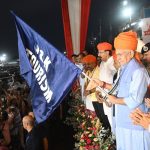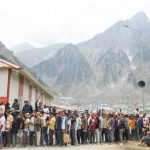As the mercury levels recorded a drop in Delhi and the National Capital Region (NCR), a thick layer of fog engulfed the national capital and adjoining areas leading to reduced visibility on Monday.
Visibility in the region dropped to less than 25m around 6 am and the vehicles were seen with their headlights on during the morning hours. People were seen around gas stations and on street corners huddled around large bonfires to beat the cold.
“Visibility recorded at 5:30 am today in Bhatinda-0 metres, Amritsar-25 and Ambala-25 metres each, Hissar-50 metres, Delhi (Safdarjung)-25 metres, Delhi (Palam)-50 metres; Uttar Pradesh: Agra-0 metre, Lucknow (Amausi)-0 metres, Varanasi (Babatpur)-25 metres, Bareilly-50 metres,” according to the data from India Meteorological Department (IMD).
As per Satellite imagery and available visibility data from the IMD, the fog layer extended from Punjab and adjoining northwest Rajasthan to Bihar across Haryana, Chandigarh and Delhi and Uttar Pradesh.
The dense fog that engulfed the national capital caused delays in flight operations at the Indira Gandhi International Airport (IGIA). Just past midnight, the IGIA issued a statement saying: “Low visibility procedures are in progress at Delhi airport….Passengers are requested to contact the airline concerned for updated flight reactions.”
As many as 29 trains were running late in the Northern Railway region alone on Monday, due to fog, including the Rajdhani Express trains. Delayed due to fog and cold, passengers were seen facing a lot of problems.
As per the data from Indian Railways: “Anvt Garib Rath is running 7 hours late, Sealdah Rajdhani Express 11:30 hours late, Howrah Rajdhani Express 10:30 hours late, Jainagar Garib Rath Express 10:30 hours late, New Delhi Bhuneshwar Rajdhani Express 09 hours late, Duranto Express 13:30 hours late, among others,”
The air quality was in the ‘Severe’ category with an overall AQI of 422 in Delhi today. A thick layer of fog also covered Noida and parts of Gurugram.
The Air Quality Index from 0 to 100 is considered as good, while from 100 to 200 it is moderate, from 200 to 300 it is poor, and from 300 to 400 it is said to be very poor and from 400 to 500 or above it is considered as severe.
According to the System of Air Quality and Weather Forecasting and Research (SAFAR), Delhi’s air quality was also recorded to be in the upper end of the ‘very poor’ category on Sunday. (ANI)








